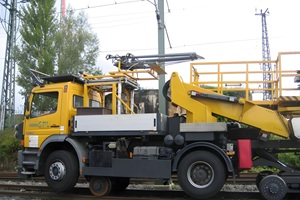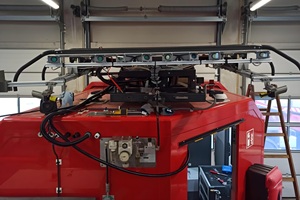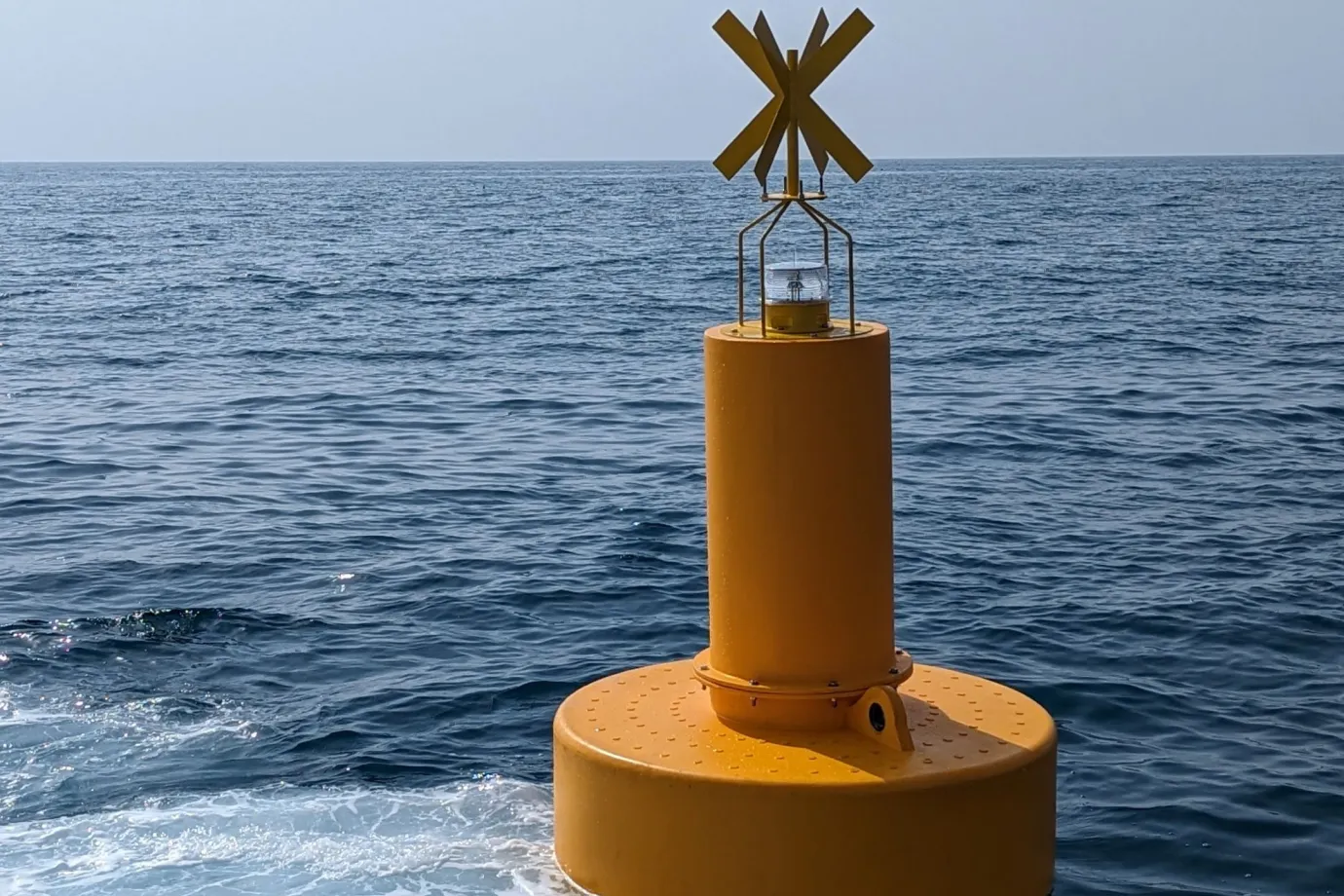Overhead Line Equipment (OLE) is a fundamental part of railway electrification systems and is responsible for delivering electrical power to trains. This complex network of components ensures that the necessary power is consistently supplied, allowing trains to operate efficiently. Whether familiar with railway systems or new to the concept, understanding OLE is essential to learning how electrified railways function.
In this blog post, we’ll break down the key components of OLE, such as contact wires, cantilevers, insulators, and tensioning devices. We’ll also explore the various types of OLE systems, including the differences between AC and DC systems and how they are used in different railway environments. Additionally, we’ll guide you through how OLE works to transmit electrical power and the common issues that can arise with its operation.
Get real-time insights with our “overhead contact line monitoring system“, designed to detect wear, sag, and contact issues before they disrupt operations.

What is Overhead Line Equipment (OLE)?

Overhead Line Equipment (OLE) is the infrastructure to transmit electrical power to trains in electrified railway systems. It consists of various components, such as contact wires, insulators, and cantilevers, that deliver electricity from substations to trains. This setup allows electric trains to receive a continuous energy flow, ensuring efficient and environmentally friendly rail transport.
The primary purpose of OLE is to maintain a consistent supply of electrical power while trains are in motion. It achieves this by suspending a network of overhead wires above the railway tracks, from which trains draw energy via pantographs attached to their roofs. These pantographs make direct contact with the energized wires, allowing the transfer of power needed to drive the electric motors in trains. This system eliminates the need for onboard power sources like diesel engines, making electrified railways more energy-efficient and reducing emissions.
OLE ensures smooth and efficient train operations in modern railway infrastructure. It also allows for higher speeds and reduced fuel costs, making it an essential part of urban transit networks and long-distance rail systems.
See also: “An Overview of Catenary System Inspections.”
Exploring the Components of Overhead Line Equipment (OLE)

Overhead Line Equipment (OLE) is essential to railway electrification, ensuring electrical power transmission to trains. It consists of a network of components working in unison to maintain a consistent connection between the train’s pantograph and the power source. Understanding each component’s role provides insight into how the OLE system functions efficiently. While contact wires, cantilevers, and tensioning devices are well-known elements, other vital parts, such as catenary wires and section insulators, also contribute to the system’s effectiveness.
Contact Wires
The contact wire is the primary conductor in the OLE system, through which trains receive electrical power. It is made from durable, high-conductivity materials such as copper or copper alloys to withstand continuous wear from the pantograph while transmitting high current levels. Positioned precisely above the track, the contact wire must remain stable and aligned to ensure consistent power delivery, even as the train moves at high speeds.
Stay ahead of maintenance with continuous “catenary wire wear diagnostics” built to protect your infrastructure and improve lifecycle planning.

Cantilevers
Cantilevers are the arms that extend from support structures, such as poles or masts, to hold the contact wire above the railway. They are critical in ensuring the contact wire remains properly positioned laterally and vertically. Cantilevers prevent sagging and misalignment, which could lead to disruptions in power transfer and train operations.
Insulators
Insulators in the OLE system are designed to prevent the flow of electricity into unwanted areas, such as support poles or surrounding structures. These components, typically made from non-conductive materials like porcelain or polymer, are essential for maintaining system safety and preventing electrical shorts. Insulators separate live components from the grounded parts of the system, ensuring the safe operation of electrified railways.
Droppers
Droppers are wires or rods that connect the contact wire to the catenary (messenger) wire, ensuring that the two wires remain the correct distance apart. They maintain the contact wire’s vertical positioning, preventing it from sagging. Proper tension in the droppers is crucial to stabilizing the contact wire and ensuring the pantograph maintains contact.
Catenary (Messenger) Wire
The catenary or messenger wire runs parallel to the contact wire and suspends it via droppers. This wire supports the weight of the contact wire and distributes it evenly along the system. The catenary wire is typically tensioned to counteract the effects of gravity and temperature changes, ensuring that the contact wire remains in place and functions effectively.
Tensioning Devices
Tensioning devices maintain the proper tension in the contact and catenary wires. These devices help compensate for environmental factors, such as temperature fluctuations, that can cause the wires to expand or contract. Keeping the wires under constant tension ensures that the system operates smoothly and that the wires remain aligned, preventing operational failures.
Support Masts and Gantries
Support masts and gantries are structural components that support the entire OLE system. They provide the physical framework for the cantilevers, contact, and catenary wires. Strategically placed along the railway line, they ensure the system remains stable and functional, even over long stretches of track.
Section Insulators and Neutral Sections
Section insulators divide the OLE system into electrically independent segments, allowing localized maintenance without affecting the entire network. Neutral sections, conversely, are non-electrified gaps between different power systems or phases on the railway. These components ensure the safe and efficient operation of the OLE, particularly in areas where multiple electrical systems intersect.
These interconnected components are essential for the smooth operation of overhead line equipment, supporting the electrification of railways across various environments. Each part plays a specific role in ensuring that trains receive uninterrupted power, allowing for efficient, high-speed rail transport. Understanding these elements is crucial for both maintaining and optimizing OLE systems globally.
How Does Overhead Line Equipment Power Railway Systems?

Overhead line Equipment (OLE) is the backbone of modern electrified railways and supplies continuous electrical power to trains. The OLE system consists of a network of wires, poles, and supporting structures designed to ensure that trains receive uninterrupted power while moving along the tracks. The installation process of OLE is highly technical and requires precision to ensure reliability and safety.
Installation Process of OLE
The installation begins with regularly placing support masts or poles along the railway track. These masts hold the cantilevers, which extend horizontally over the tracks and support the contact wires. The contact wires are suspended above the track, ensuring they are at the correct height for trains to draw power.
Next, a catenary wire is installed above the contact wire. The catenary wire helps distribute the load and weight of the contact wire and is attached to it by droppers. These droppers ensure the contact wire remains at a constant height, crucial for maintaining an uninterrupted connection with the train’s pantograph. Insulators also separate live electrical components from grounded structures, providing electrical isolation for safety.
Transmission of Power to Trains
Once installed, the OLE system transmits electrical power to the train via the pantograph mounted on the train’s roof. The pantograph contacts the live contact wire as the train moves, allowing electricity to flow from the overhead wires to the train’s electric motor. The catenary system helps maintain tension in the wires, allowing for smooth power transmission even at high speeds.
Importance of Wire Tension
Wire tension plays a critical role in the smooth functioning of OLE. Tensioning devices keep the contact and catenary wires under constant tension, compensating for temperature changes that may cause the wires to expand or contract. Proper tension prevents sagging and ensures the pantograph maintains continuous contact with the wire, avoiding power loss and operational disruptions.
OLE enables efficient, reliable rail transport, particularly in high-speed and long-distance applications, by ensuring that all components work together seamlessly.
Common Overhead Line Equipment (OLE) Failures

Overhead Line Equipment (OLE) is susceptible to various failures that can disrupt railway operations. Here are some of the most common problems:
Weather-Related Failures
Weather can significantly affect the performance of OLE systems. In extreme heat, overhead wires can expand and sag, potentially causing misalignment and reducing the effectiveness of power transmission. On the other hand, cold weather can lead to ice buildup on the wires, which increases tension and can cause breakage or additional stress on the system. High winds also pose a threat by blowing debris or vegetation onto the wires, which can lead to short circuits or physical damage to the system.
Equipment Fatigue
Over time, OLE components experience mechanical wear and tear due to continuous use. Parts such as contact wires, droppers, and insulators can deteriorate, especially in high-speed rail systems where constant contact between the pantograph and the wires results in progressive wear. Additionally, tensioning devices may lose their ability to maintain proper wire tension, affecting the system’s smooth operation. The system’s performance can also degrade when these components are not regularly inspected and replaced as needed.
Power Supply Failures
In some cases, the power supply feeding the OLE can fail, disrupting the flow of electricity to trains. This failure could be due to electrical grid issues or a local power distribution system fault. A power failure can affect large areas of the rail network, causing widespread delays.
Wildlife and Debris
Wildlife-like birds can sometimes land on the OLE, causing short circuits. Additionally, vegetation or debris blown by the wind may interfere with the wires, potentially leading to a loss of contact or damage. These issues can cause sudden service interruptions until the affected components are repaired or removed.
Regular Inspections and Preventive Measures
Regular inspections and preventive maintenance are crucial to prevent failures and ensure the smooth functioning of the OLE system.
Routine Maintenance and Inspections
Scheduling regular inspections of OLE components is essential for identifying early signs of wear or damage. Inspections should include checking wire tension, alignment, and the condition of the contact wires, droppers, and tensioning devices. By catching issues early, operators can replace or repair parts before they lead to costly breakdowns or service interruptions.
See also: “Railway Inspection and Measurement Systems.“
Automated Monitoring Systems
Automated inspection tools like drones and smart sensors are becoming increasingly popular in modern railway networks. These technologies allow for real-time monitoring of the OLE system, enabling rail operators to detect problems as they occur. Sensors can continuously monitor wire tension and alignment, alerting maintenance teams when adjustments are necessary.
Vegetation and Wildlife Management
Proper management of surrounding vegetation helps prevent damage from falling branches or debris. Regular clearing of vegetation along the railway can reduce the risk of interruptions caused by environmental factors. Wildlife deterrents can also be installed to prevent birds and other animals from interfering with the OLE system.
By implementing these preventive measures, railway operators can minimize the risk of OLE failures and ensure the continuous operation of electrified railway systems.
Conclusion
In conclusion, Overhead Line Equipment (OLE) is essential to modern railway electrification systems, ensuring continuous electrical power supply to trains. Rail operators can maintain efficient and reliable rail transport systems by understanding their key components, contact wires, cantilevers, insulators, and tensioning devices. However, OLE is susceptible to various challenges, including weather-related wear, equipment fatigue, and the need for regular inspections.
Addressing these issues requires a proactive approach. Implementing regular maintenance schedules, deploying automated inspection technologies, and managing external factors like vegetation and wildlife are crucial preventive measures. By doing so, railway operators can minimize service disruptions, improve system longevity, and ensure safe and efficient train operations.
As railway electrification continues to evolve, especially with the integration of high-speed rail and advanced monitoring technologies, maintaining and upgrading OLE systems will remain a top priority. Effective management of OLE components supports the smooth functioning of railways and contributes to sustainable and energy-efficient rail transport, which is essential for future growth.




